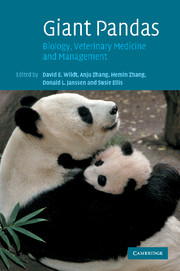Book contents
- Frontmatter
- Contents
- List of contributors
- Foreword
- Acknowledgements
- 1 The giant panda as a social, biological and conservation phenomenon
- 2 The Giant Panda Biomedical Survey: how it began and the value of people working together across cultures and disciplines
- 3 Factors limiting reproductive success in the giant panda as revealed by a Biomedical Survey
- 4 Significant medical issues and biological reference values for giant pandas from the Biomedical Survey
- 5 Life histories and behavioural traits as predictors of breeding status
- 6 Nutrition and dietary husbandry
- 7 Male reproductive biology in giant pandas in breeding programmes in China
- 8 Endocrinology of the giant panda and application of hormone technology to species management
- 9 The value and significance of vaginal cytology
- 10 Parentage assessment among captive giant pandas in China
- 11 The science of behavioural management: creating biologically relevant living environments in captivity
- 12 Evaluating stress and well-being in the giant panda: a system for monitoring
- 13 The neonatal giant panda: hand-rearing and medical management
- 14 Consequences of early rearing on socialization and social competence of the giant panda
- 15 Medical management of captive adult and geriatric giant pandas
- 16 Diseases and pathology of giant pandas
- 17 Ultrasonography to assess and enhance health and reproduction in the giant panda
- 18 Gastrointestinal endoscopy in the giant panda
- 19 Historical perspective of breeding giant pandas ex situ in China and high priorities for the future
- 20 Role and efficiency of artificial insemination and genome resource banking
- 21 Analysis of demographic and genetic trends for developing a captive breeding masterplan for the giant panda
- 22 Partnerships and capacity building for securing giant pandas ex situ and in situ: how zoos are contributing to conservation
- Index
- Plate Section
- References
10 - Parentage assessment among captive giant pandas in China
Published online by Cambridge University Press: 09 August 2009
- Frontmatter
- Contents
- List of contributors
- Foreword
- Acknowledgements
- 1 The giant panda as a social, biological and conservation phenomenon
- 2 The Giant Panda Biomedical Survey: how it began and the value of people working together across cultures and disciplines
- 3 Factors limiting reproductive success in the giant panda as revealed by a Biomedical Survey
- 4 Significant medical issues and biological reference values for giant pandas from the Biomedical Survey
- 5 Life histories and behavioural traits as predictors of breeding status
- 6 Nutrition and dietary husbandry
- 7 Male reproductive biology in giant pandas in breeding programmes in China
- 8 Endocrinology of the giant panda and application of hormone technology to species management
- 9 The value and significance of vaginal cytology
- 10 Parentage assessment among captive giant pandas in China
- 11 The science of behavioural management: creating biologically relevant living environments in captivity
- 12 Evaluating stress and well-being in the giant panda: a system for monitoring
- 13 The neonatal giant panda: hand-rearing and medical management
- 14 Consequences of early rearing on socialization and social competence of the giant panda
- 15 Medical management of captive adult and geriatric giant pandas
- 16 Diseases and pathology of giant pandas
- 17 Ultrasonography to assess and enhance health and reproduction in the giant panda
- 18 Gastrointestinal endoscopy in the giant panda
- 19 Historical perspective of breeding giant pandas ex situ in China and high priorities for the future
- 20 Role and efficiency of artificial insemination and genome resource banking
- 21 Analysis of demographic and genetic trends for developing a captive breeding masterplan for the giant panda
- 22 Partnerships and capacity building for securing giant pandas ex situ and in situ: how zoos are contributing to conservation
- Index
- Plate Section
- References
Summary
INTRODUCTION
While many recent advances have been made in the breeding of giant pandas ex situ, historically this species has never reproduced well in captivity. Sexual incompatibility, health problems, low fecundity and a juvenile mortality rate in excess of 70% have contributed to low reproductive success (O'Brien & Knight, 1987; O'Brien et al., 1994; Peng et al., 2001a, b). Wild- and captive-born giant pandas, particularly those captured at a young age, traditionally had difficulty producing offspring in captivity upon becoming adults (Lu & Kemf, 2001). As a result, the ex-situ giant panda population has not been self-sustaining and, until recently, its growth has relied on introducing animals captured from nature. In some cases, this included individuals that appeared ill (rescues) or cubs that were believed to be neglected or abandoned by their mothers. Later field studies, however, revealed that females often leave cubs alone for four to eight hours while foraging, and in one documented case for 52 hours (Lu et al., 1994). Recently, China has placed a general moratorium on capturing wild giant pandas for captive breeding (Lu & Kemf, 2001), a move that forces the breeding community to develop a self-sustaining population.
The goal, however, is not only ensuring demographic self-sustainability but also the maintenance of genetic diversity. The deleterious effects of inbreeding are well recognised (O'Brien, 1994a; Frankham, 1995; Hedrick & Kalinowski, 2001; Frankham et al., 2002).
- Type
- Chapter
- Information
- Giant PandasBiology, Veterinary Medicine and Management, pp. 245 - 273Publisher: Cambridge University PressPrint publication year: 2006
References
- 2
- Cited by



